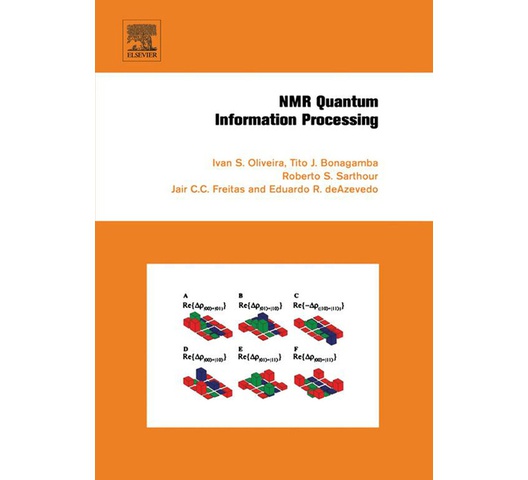
NMR Quantum Information Processing
by Oliveira, Ivan, Sarthour, Jr. Roberto, Bonagamba, Tito
This is an eBook that you can download electronically.
Quantum Computation and Quantum Information (QIP) deals with the identification and use of quantum resources for information processing. This includes three main branches of investigation: quantum algorithm design, quantum simulation and
quantum communication, including quantum cryptography. Along the past few years, QIP has become one of the most active area of
research in both, theoretical and experimental physics, attracting students and researchers fascinated, not only by the potential
practical applications of quantum computers, but also by the possibility of studying fundamental physics at the deepest level of quantum phenomena.
NMR Quantum Computation and Quantum Information Processing describes the fundamentals of NMR QIP, and the main developments which can lead to a large-scale quantum processor.
The text starts with a general chapter on
the interesting topic of the physics of computation. The very first ideas which sparkled the development of QIP came from basic considerations of the physical processes underlying computational actions. In Chapter 2 it is made an introduction to NMR, including the hardware and other experimental aspects of the technique. In
Chapter 3 we revise the fundamentals of Quantum Computation and Quantum Information. The chapter is very much based on the extraordinary book of Michael A. Nielsen and Isaac L. Chuang, with
an upgrade containing some of the latest developments, such as QIP in phase space, and telecloning. Chapter 4 describes how NMR
generates quantum logic gates from radiofrequency pulses, upon which quantum protocols are built. It also describes the important technique of Quantum State Tomography for both, quadrupole and spin
1/2 nuclei. Chapter 5 describes some of the main experiments of quantum algorithm implementation by NMR, quantum simulation and QIP in phase space. The important issue of entanglement in NMR QIP
experiments is discussed in Chapter 6. This has been a particularly exciting topic in the literature. The chapter contains a discussion
on the theoretical aspects of NMR entanglement, as well as some of the main experiments where this phenomenon is reported. Finally, Chapter 7 is an attempt to address the future of NMR QIP, based in
very recent developments in nanofabrication and single-spin detection experiments. Each chapter is followed by a number of problems and solutions.
* Presents a large number of problems with solutions, ideal for students
* Brings together topics in different areas: NMR, nanotechnology, quantum computation
* Extensive references
SKU: 9780080497525
Format: PDF
quantum communication, including quantum cryptography. Along the past few years, QIP has become one of the most active area of
research in both, theoretical and experimental physics, attracting students and researchers fascinated, not only by the potential
practical applications of quantum computers, but also by the possibility of studying fundamental physics at the deepest level of quantum phenomena.
NMR Quantum Computation and Quantum Information Processing describes the fundamentals of NMR QIP, and the main developments which can lead to a large-scale quantum processor.
The text starts with a general chapter on
the interesting topic of the physics of computation. The very first ideas which sparkled the development of QIP came from basic considerations of the physical processes underlying computational actions. In Chapter 2 it is made an introduction to NMR, including the hardware and other experimental aspects of the technique. In
Chapter 3 we revise the fundamentals of Quantum Computation and Quantum Information. The chapter is very much based on the extraordinary book of Michael A. Nielsen and Isaac L. Chuang, with
an upgrade containing some of the latest developments, such as QIP in phase space, and telecloning. Chapter 4 describes how NMR
generates quantum logic gates from radiofrequency pulses, upon which quantum protocols are built. It also describes the important technique of Quantum State Tomography for both, quadrupole and spin
1/2 nuclei. Chapter 5 describes some of the main experiments of quantum algorithm implementation by NMR, quantum simulation and QIP in phase space. The important issue of entanglement in NMR QIP
experiments is discussed in Chapter 6. This has been a particularly exciting topic in the literature. The chapter contains a discussion
on the theoretical aspects of NMR entanglement, as well as some of the main experiments where this phenomenon is reported. Finally, Chapter 7 is an attempt to address the future of NMR QIP, based in
very recent developments in nanofabrication and single-spin detection experiments. Each chapter is followed by a number of problems and solutions.
* Presents a large number of problems with solutions, ideal for students
* Brings together topics in different areas: NMR, nanotechnology, quantum computation
* Extensive references
KES 31,528

International delivery
Free click & collect
When you buy an ebook from TBC, you will be given a code to download your
purchase from our ebook partner Snapplify. After you have redeemed the code and
associated it with a Snapplify account, you'll need to download the Snapplify Reader
to read your ebooks. The free Snapplify Reader app works across iOS, Android,
Chrome OS, Windows and macOS; on tablets and mobile devices, as well as on
desktop PCs and Apple Macs.
You're currently browsing Text Book Centre's digital books site. To browse our range of physical books as well as a wide selection of stationery, art supplies, electronics and more, visit our main site at textbookcentre.com!
Reviews
This product does not have any reviews yet.
Add your review
